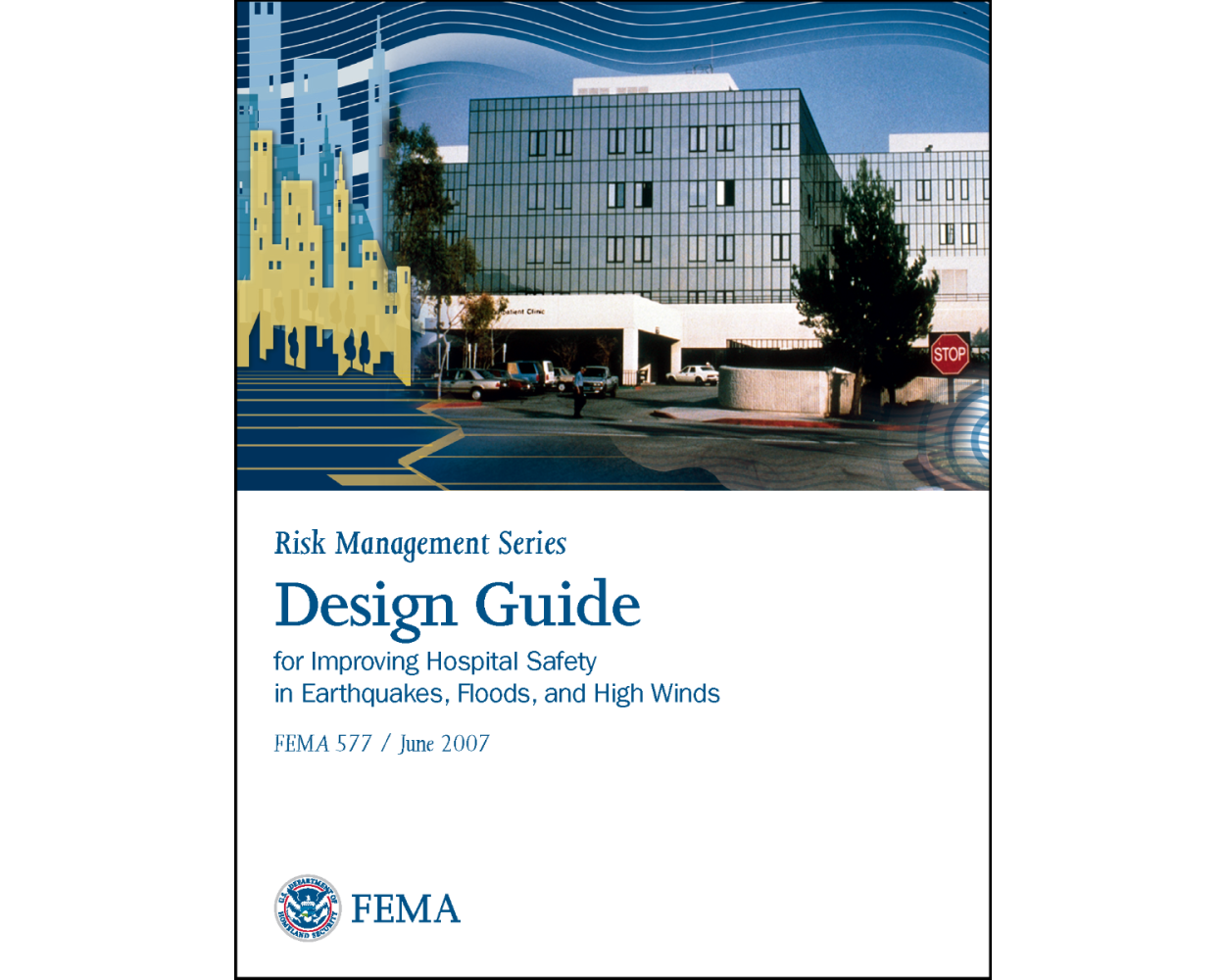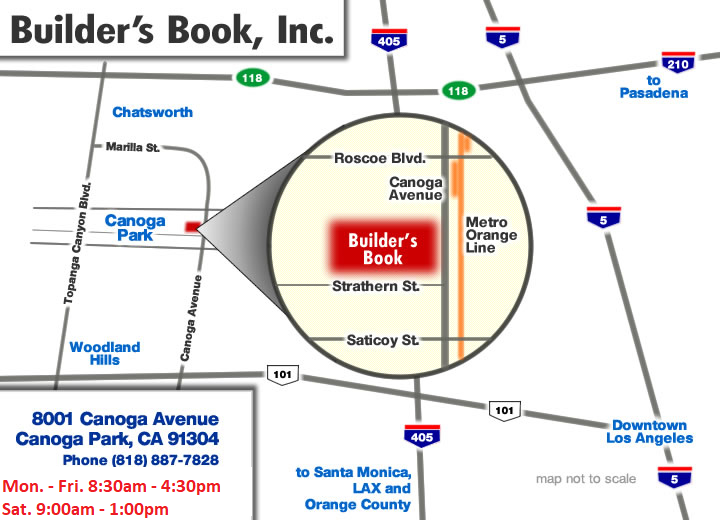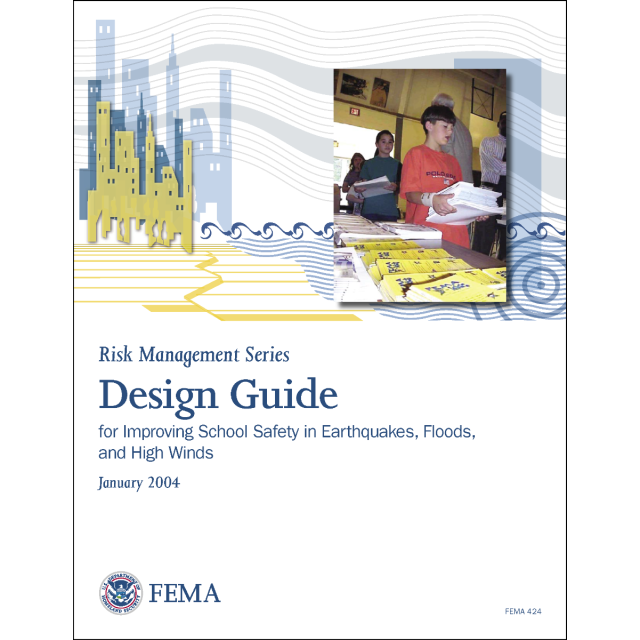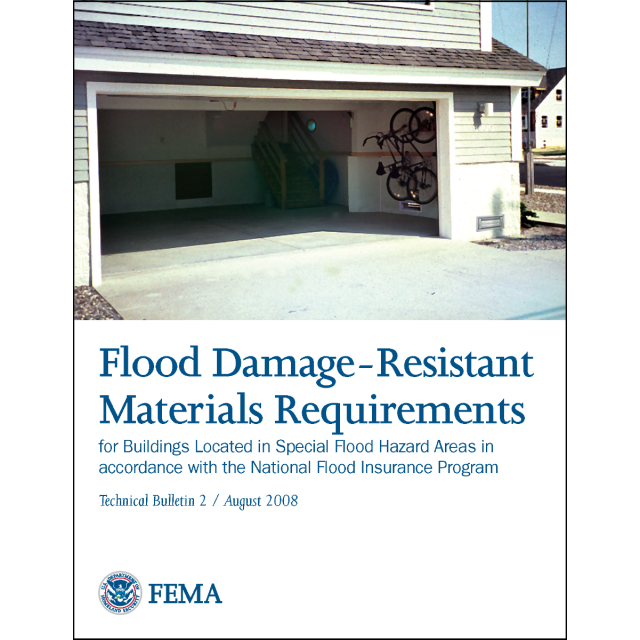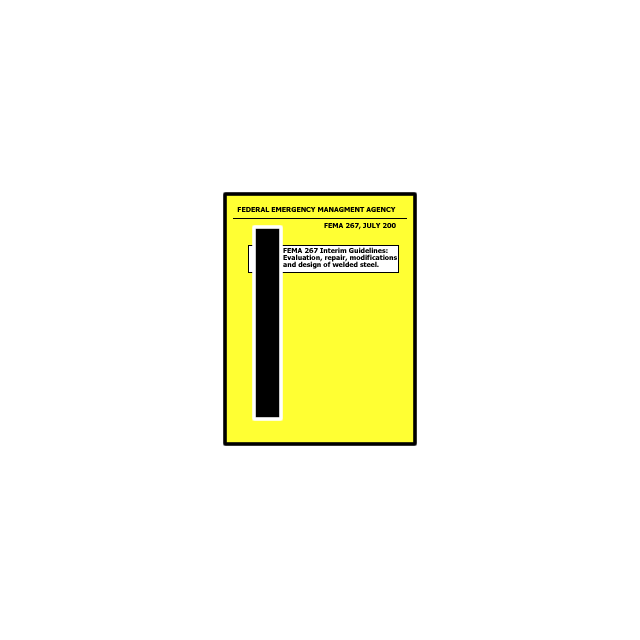Design Guide for Improving Hospital Safety in Earthquakes, Floods, and High Winds FEMA 577
Risk Management Series -Design Guide for Improving Hospital Safety in Earthquakes, Floods, and High Winds FEMA 577
OBJECTIVE AND SCOPE
The objective of the “Design Guide for Improving Hospital Safety in Earthquakes, Floods, and High Winds” is to inform and assist design professionals, hospital administrators, and facility managers in implementing sound mitigation measures that will decrease the vulnerability of hospitals to disruptions caused by natural hazard events. The intent of the Design Guide is to provide its audience with state-of-the-art knowledge on the variety of vulnerabilities faced by hospitals exposed to earthquakes, flooding, and high-winds risks, as well as the best ways to mitigate the risk of damage and disruption of hospital operations caused by these events.
The information presented in this publication provides an exhaustive review of mitigation measures and design solutions that can improve the safety of hospitals in natural hazard events. However, this publication is not intended to be a comprehensive mitigation design manual that the reader can use to develop actual plans and specifications. It is intended as an introduction to the fundamental principles of natural hazard risk reduction, with an emphasis on mitigation planning and the design of hospital buildings. The information presented here is intended to help design professionals, hospital administrators, and facility managers understand the broad aspects of risk reduction methods and strategies, and integrate them into hospital designs.
ORGANIZATION AND CONTENT
The Design Guide is organized around three specific natural hazards: earthquakes, floods, and high winds. It comprises four main chapters.
Chapter 1 presents an overview of the principal considerations determining hospital design, from standard industry requirements to new developments that are transforming both hospital operations and organization of the physical environment. It highlights the known vulnerabilities of hospitals and the repercussions of damage caused by natural hazard events that frequently interfere with the operation of these facilities. The chapter concludes with a look at the multi-hazard approach to hospital design, and provides basic guidelines on the interaction between the responses of building components to various natural hazard risks.
Chapter 2 examines potential earthquake damage to hospitals, and how these facilities can most efficiently improve their performance. Thechapter opens with an introductory discussion on the nature and probability of earthquakes, and procedures for determining seismic risk to specific locations. Typical seismic damages, and the possible resulting effects on building functions or risk to occupants, are described and related to the standard damage states currently used in performance-based earthquake engineering design. The chapter ends with a review of the best practices in seismic design and seismic retrofit of hospital facilities.
Chapter 3 discusses the nature of flood forces and their effects on buildings. It outlines the procedures for risk assessment and describes the current mitigation measures for reducing flood damage. It emphasizes the benefits of avoiding construction of new hospitals in high-risk areas, describes regulatory design requirements that help reduce the exposure of hospitals that must be located in flood hazard areas, and encourages the application of appropriate mitigation measures to existing hospitals at risk of flooding.
Chapter 4 discusses the effects of wind forces on hospitals’ structural and nonstructural building components. By reviewing numerous examples of wind-induced damage to these facilities, this chapter highlights the best mitigation practices for new hospital design and construction, and for the rehabilitation of existing facilities. It concentrates on the building components that are the most critical for maintaining uninterrupted operation of hospitals, and provides detailed guidelines for improving their design and construction.
At the end are Appendix A, which contains a list of acronyms, and Appendix B, which contains a glossary of terms that appear in the Design Guide.
| Price | $34.95 |
|---|---|
| Customer Service | We're Here To Help Call us anytime during our customer service hours... Monday through Friday - 8:30 am to 4:30 pm (Pacific) Order Questions:
TOLL FREE, 800-273-7375 (Outside the U.S. call 818-887-7828). Our Address: 8001 Canoga Avenue Canoga Park, CA 91304 US Phone: 800-275-2665 E-mail: sales@buildersbook.com
|
| Description | Risk Management Series -Design Guide for Improving Hospital Safety in Earthquakes, Floods, and High Winds FEMA 577 OBJECTIVE AND SCOPE The information presented in this publication provides an exhaustive review of mitigation measures and design solutions that can improve the safety of hospitals in natural hazard events. However, this publication is not intended to be a comprehensive mitigation design manual that the reader can use to develop actual plans and specifications. It is intended as an introduction to the fundamental principles of natural hazard risk reduction, with an emphasis on mitigation planning and the design of hospital buildings. The information presented here is intended to help design professionals, hospital administrators, and facility managers understand the broad aspects of risk reduction methods and strategies, and integrate them into hospital designs. ORGANIZATION AND CONTENT Chapter 1 presents an overview of the principal considerations determining hospital design, from standard industry requirements to new developments that are transforming both hospital operations and organization of the physical environment. It highlights the known vulnerabilities of hospitals and the repercussions of damage caused by natural hazard events that frequently interfere with the operation of these facilities. The chapter concludes with a look at the multi-hazard approach to hospital design, and provides basic guidelines on the interaction between the responses of building components to various natural hazard risks. Chapter 2 examines potential earthquake damage to hospitals, and how these facilities can most efficiently improve their performance. Thechapter opens with an introductory discussion on the nature and probability of earthquakes, and procedures for determining seismic risk to specific locations. Typical seismic damages, and the possible resulting effects on building functions or risk to occupants, are described and related to the standard damage states currently used in performance-based earthquake engineering design. The chapter ends with a review of the best practices in seismic design and seismic retrofit of hospital facilities. Chapter 3 discusses the nature of flood forces and their effects on buildings. It outlines the procedures for risk assessment and describes the current mitigation measures for reducing flood damage. It emphasizes the benefits of avoiding construction of new hospitals in high-risk areas, describes regulatory design requirements that help reduce the exposure of hospitals that must be located in flood hazard areas, and encourages the application of appropriate mitigation measures to existing hospitals at risk of flooding. Chapter 4 discusses the effects of wind forces on hospitals’ structural and nonstructural building components. By reviewing numerous examples of wind-induced damage to these facilities, this chapter highlights the best mitigation practices for new hospital design and construction, and for the rehabilitation of existing facilities. It concentrates on the building components that are the most critical for maintaining uninterrupted operation of hospitals, and provides detailed guidelines for improving their design and construction. |

